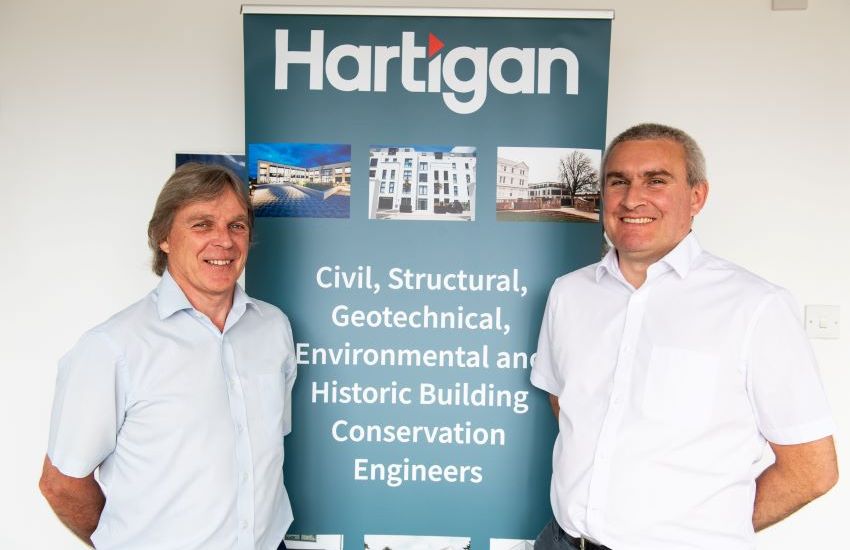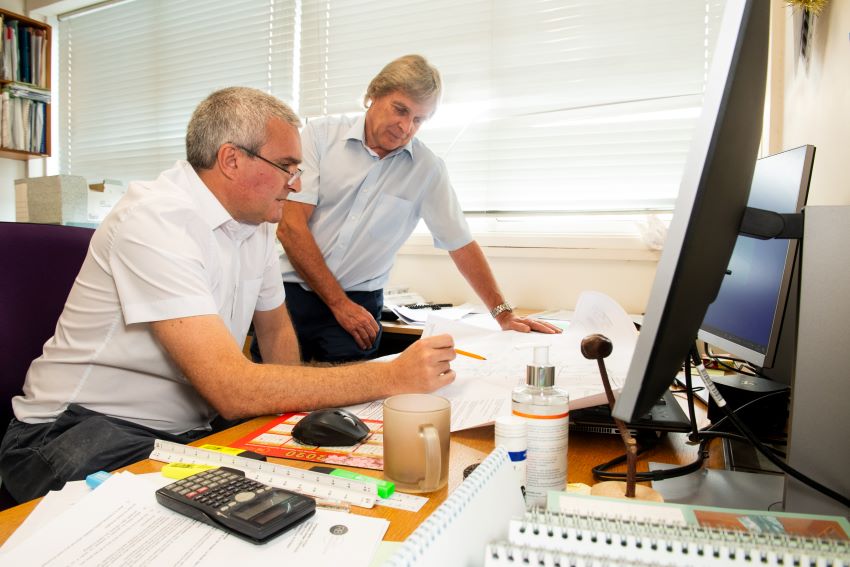


Hartigan has taken on projects of all shapes and sizes since it was established in 1984. As the firm celebrates its 40th birthday, two of its senior team took a moment reflected on how engineering has changed over the decades, and how it can keep evolving to meet the construction needs of Jersey in the future. [spon]
Here's what Colin Tadier, Managing Director, and Andrew Romeril, Director of Hartigan, had to say...
40 years sounds like a long time in business, but when your business is helping create and preserve products that need to last a lifetime, in comparison it’s just a brief moment.
The ‘products’ Hartigan is involved with range in scale and diversity from houses to harbours, parish churches to puffins, from infrastructures holding 120-ton turbines to a green wall enmeshed by the perfect mix of plants.
“As engineers we like challenges and it’s our job to look at ways to help make construction projects possible.” Colin Tadier, Managing Director, Hartigan, explained.
Over his 38 years with the company, Colin has seen Hartigan grow from a handful of engineers to a team of nearly 20, offering services from building design to infrastructure, inspection and condition surveys, and geotechnical reports.
“I don’t know where the time has gone. When Dan Hartigan started the business in 1984 it was initially just him. I joined in 1986 as the island experienced a construction boom, with work coming in both from the public and private sectors. Over the years we have expanded and developed the business to meet the changing needs of the industry. However, we always stand by our original principle – to maintain the highest standards and ensure a project serves its purpose.”

Pictured: "I joined in 1986 as the island experienced a construction boom, with work coming in both from the public and private sectors."
When Andrew Romeril, Director of Civil and Structural Engineering, joined Hartigan 22 years ago, designs were still done on paper, with teams often only seeing what other specialities were planning when they all arrived on site.
“The shift from pen and paper to Computer Aided Design (CAD), was instrumental in taking the business forward. Once we began sharing documents electronically, by email, rather than by post or fax, we were able to speed up communication channels between architects, designers, and builders, so we can all see what everyone is planning. This means that the wider team working on a project get a better understanding of what we are specifying from a structural perspective, and we can collaborate to make projects come together more efficiently.
“The next stage is 3-D modelling, using AI to find the points where different models from each of the specialities don’t fit. As this evolves, we will most likely move to one model in the cloud where architects, designers, builders, and structural engineers can all work together in real time on one building information model.”
This investment in training, technology, and its own systems also means Hartigan can work with larger off-island firms who are frequently brought in to manage significant infrastructure projects like Les Quennevais School. For this, Hartigan’s Structural and Civil Engineering Team worked with the Government of Jersey’s Architectural team, alongside UK teams to deliver a modern teaching space for 850 pupils.
Andrew said: “Jersey has a significant amount more on-island expertise for construction than might be expected for somewhere our size, but occasionally we need to bring in off-island skills. By upgrading our systems, we can integrate with international architects, designers, and consultants, to deliver bigger projects for the island. This has the advantage of ensuring more work remains in the island and allowing the island to gain international expertise for future developments.”
While some businesses may have gone down a path of narrower specialisation, Hartigan has expanded its expertise to deliver more services for island needs. For example, in the areas of sustainability and historic building conservation.
Colin said: “As engineers we know the energy savings on a building that is constructed the right way can be high, however, building new, to these standards can also be energy intensive in terms of the quantity of new materials you need. Working out what is ‘best’ in terms of sustainability can be a complex balancing act.
"Retrofitting a building, and reusing as much as you can, is a challenge and requires a greater level of experience and understanding of what older buildings require to operate efficiently. For example, buildings from the 1950s, 1960s, and 1970s were designed to be better ventilated and improving insulation, to reduce the amount of energy required to heat them, can cause condensation.
“There’s a certain way we need to deal with retrofitting buildings from different eras which is not always well understood, and we are going through a period when mistakes might be made. However, in context you must consider what would be going to landfill when you remove an old building and start again.”
When it comes to historic building conservation, the solutions can be even more complex.
“With College Gardens, the former Jersey College for Girls building had been derelict for many years, so we had to investigate the fabric of the building, using lab analysis to see what was happening to the building materials as salt can cause deterioration.
"We did a Heritage Impact Assessment, looking at ways to mitigate the impact of the new development on the old building, for example, protecting remnants of different eras, such as the WW2 Swastika on the front which had to be sealed before it was covered up, or the dome which contains the engraved initials of many generations of students.”
Hartigan has also worked on restoration projects for several island churches, including St Thomas’s where they specified the protective scaffolding around the 60m high tower with a temporary tensioning system to keep the tower intact during masonry repairs – all while working under covid restrictions.
Andrew said: “Heritage projects involve unique skills with bespoke solutions for unusual problems. It can also be hard to know exactly what problem you are looking at until work begins, and masonry is stripped back. With St James’s Church, we anticipated dry rot, however, it was only when you got into it you could see the rot was going up the middle of the timbers. But even modern buildings can throw up surprises.
"Everything has a weak point, for example, the metal sheeting that came off buildings in last year’s storms may have been vulnerable because the fixings had corroded.”
Building on experience while developing new skills and adopting new technology is one part of Hartigan’s story. Retaining talent is another.
“Many of us have been here for over 20 years,” Colin said.

Pictured: "We are growing the next generation of engineers here too."
“And we are growing the next generation of engineers here too," he continued. "We have assisted with developing the school curriculum for Design, Engineering and Construction, giving young people the opportunity to understand what the industry does, and we have been involved with establishing the Engineering degree course at Highlands where local students can study for a qualification here while working, then go on to achieved chartered status.
"We are also working with the Institute of Civil Engineers and have six engineers working on their post-degree qualifications.”
While it’s impossible to say what Hartigan might look like in another 40 years, there’s a good chance even the quirkiest of projects they have been involved with might still be here.
Andrew said: “The Puffins at Plemont might just look like wicker, but they have a frame of steel, and a very well specified concrete base that helped them withstand Storm Ciaran better than many other structures in the island.
"No matter how big or how small the project, every structure needs to fulfil the timeframe it is designed for, or potentially exceed it if Jersey is to build a future that is secure and sustainable.”
This article first appeared in the July issue of Connect Magazine – read the digital edition in full below...
Comments
Comments on this story express the views of the commentator only, not Bailiwick Publishing. We are unable to guarantee the accuracy of any of those comments.